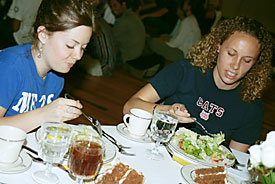 |
|
MELISSA O'NEAL/Arizona Daily Wildcat
|
Lena Ryan, a junior majoring in political science and Spanish, and Ashley Tucker, a studio art junior, sit at the "upper-class" table at a Hunger Banquet in the Student Union Memorial Center last night.
|
|
By Cara O'Connor
Arizona Daily Wildcat
Wednesday April 9, 2003
More than 50 UA students only ate rice for dinner last night.
But these students weren't going hungry; they were attendees at the 9th annual Hunger Banquet.
About 150 students that came for a free meal were surprised to find that not all would receive a full course meal. Rather, they were divided into three economic classes. The upper class was served a full meal on china and with silverware. The middle class ate beans and tortillas. And those that drew the poverty card had nothing but rice and water.
"You can talk about hunger until you die, but there is nothing like a personal experience to change someone and then change the system," said speaker Brian Flagg, director of the Casa Maria soup kitchen.
Hunger
Facts about the world's growing problem
· 1.2 billion people (about 1/5 of the world's population) live in poverty
· 800 million of these people suffer from chronic hunger
· about 24,000 people per day die from hunger and other preventable causes
· 31 million Americans do not get enough to eat
· high-income: 15 percent of the world's population makes more than $9,300 a year
· middle-income: 30 percent of the world's population makes between $750 and $9,300 a year
· low-income: 55 percent of the world's population makes less than $750 a year (about $2 a day)
|
"Being willing to personally sacrifice your time, your social privilege, that's where you start. Being willing to do something about the problem instead of just talking about it," he said.
The banquet was organized by Project Volunteer, a program under the University Activities Board, in collaboration with the Residence Hall Association, ASUA, Circle K International, the Women's Resource Center and the Residence Life El Mundo Diversity Commission.
"I am really pleased with the campus response, and I think it had a lot to do with the collaborative efforts of the groups," said Greg Billings, director of Project Volunteer.
Political science professor John Schwarz, who spoke before Flagg, said hunger is not confined to countries like Cambodia and Ethiopia, but is an issue for millions of Americans as well.
"For me the issue of hunger, the issue of economic disadvantagement, is an issue of freedom," Schwarz said, adding that tens of millions of Americans aren't really free when they face hunger and poverty issues that impede their everyday lives.
Local hunger and poverty issues, play an everyday role in Flagg's life at the Casa Maria soup kitchen. Flagg said society often relies too heavily on charity and ignores justice, but it is a good place to start. He extended an invitation to the students to volunteer at the kitchen.
"Charity is giving someone something today that satisfies their needs, like food," Flagg said. "Justice is all people having equal opportunity to better their lives, and we all create that situation."
"It's within our power to give voices to poor people so they can rise up and change things," he said.
Even though at least 30 students attended to receive extra credit for an Individuals and Societies general education class, many left with new incentive to help the community.
"I want to volunteer at Casa Maria," said media arts sophomore Phil Knittle. "Even if most of the time you're not a helpful person, you come out of here and have sparked energy."
"I was just interested in the subject matter, I think it is one of those things that doesn't get talked about even though you see the TV commercials," said Meghan Smart, a wildlife, water resources and rangeland resources sophomore.
The event required almost four months of planning, Billings said. A committee with representatives from ASUA, Circle K International, Project Volunteer and Residence Life began meeting in January to plan the event.
"Next year we expect twice the number of people," Billings said.

